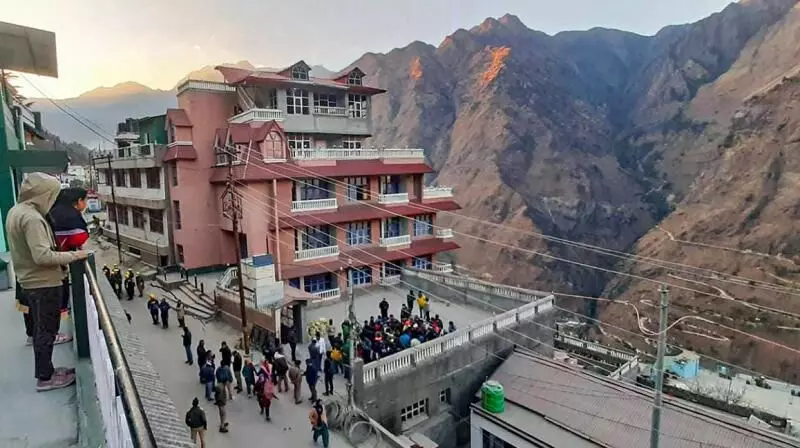Talking Shop: Dumbfounded and fumbling
We are thrust into mire that is beyond comprehension, grappling to figure out why the Himalayas are falling apart. Maybe, it is because we are disintegrating

“A nation that destroys its
soils destroys itself. Forests
are the lungs of our land,
purifying the air and giving
fresh strength to people.”
― Franklin D. Roosevelt
Let’s justify the headline above by humbly accepting that we are all similarly dumbfounded and confounded, twiddling our still-working little thumbs and index fingers, twirling them once in a while to delve into our nose, wondering what the hell is ravaging our mountains. Don’t think too far, because the reason is US. We are responsible for this mess, all of us collectively. We have individually and personally worked inscrutably hard and shamelessly to create this demise—a deadly arsenal of waste, greed and neglect, one that is now biting our softened behinds. Welcome to a new world, where not just in cities and townships, but even in the mountains, what is paramount is ‘my lawn and your yard’, ‘my parking lot and orchard’, ‘my dried heap of corn and your apple reserves’, ‘my dogs and your sheep’—which is mightier? If it is mine, I have won. In the process, we have all lost.
Let’s delve deeper. It began with the devastation in Joshimath, where houses developed cracks and roads quivered over fissures and fractures that one could put a fist through. It was nonchalantly ticked off the table as a passing phenomenon, till a pattern emerged and the deadly rout intensified, reaching Karna Prayag, Nainital, Mussoorie, Rishikesh, Gupt Kashi, Uttar Kashi and the upper parts of Himachal Pradesh. Where in Himachal Pradesh, you ask? Well, Shimla itself.
We have to grudgingly accept that the once-ruling English had their smarts about them. They built Shimla over a century back for 25,000 people at the most, and threw in a toy train and other paraphernalia for fun and personal benefit. Like it or not, we inherited this from them, as we did many other hill abodes. Since then, independent India has gone ballistic to convert these havens into money-belching machines. Take Shimla as an example—it now houses over 250,000 residents, and I am not counting the million tourists who descend into the ecosystem each year. We asked for a mess; our wish has been granted.
‘Our wish’, I daresay?
Yes, I do daresay. As mentioned above, it began with Joshimath. The overbearing and unpalatable truth is that we can do little to stem subsidence in our mountains once it begins; no one can. After all, for all of our Macarena manifestation, what can twiddle-dee-dum man do, other than consider building 10,000-foot-high walls to stop the mountains from moving when they deign to? We simply can’t do anything. What we can and have done, instead, is build a network of highways or hydel projects such as a new one at Tapovan, planned in good faith, but one that includes tunnelling in the hills and below existing townships. Residents have for long reported of crumbling houses and complained that indiscreet blasting was causing hearing problems and bursting underground aquifers, but the ‘development’ continued.
What we have managed then is to exacerbate subsidence and dangerously weaken a once-pristine ecosystem. And we are not learning our lesson even today. Under our already-shaky Uttarakhand, we are now proudly building a 15.1-km-long through-hill tunnel between Devprayag and Lachmoli, touting it to be the country’s longest. Nice. This ‘fantastic’ new line will have 12 stations, 17 tunnels, 35 bridges, and is to be completed by 2024-25. Nicer.
Let’s revisit Joshimath, the beleaguered Ground Zero, especially because the cracks there are growing wider and the situation is worsening. Over 600 families have been force-evacuated from Joshimath after a temple collapsed and houses developed cracks. “We have been requesting the Uttarakhand Government and the DM (District Magistrate) to take note of the blasts in the tunnels that cause vibrations. When our houses began developing cracks in December (2022), we wrote several letters to the Government, but got no response. The DM visited, but no action was taken. Joshimath can sink at any time,” says a prominent resident whose hotel has tilted like a famous tower at Pisa and is now at a tipping point.
‘Tipping point’, I daresay?
Sure, I do daresay. In the Chamoli district, for instance, the DM acknowledged that residents wrote to him and to the Chief Minister, but he didn’t act. “Honestly, didn’t know what to do. We needed to ascertain why the cracks were happening. Otherwise, any action without knowing the cause might have backfired. I couldn’t take any action.” The DM also demurred on allegations, claiming that power generation companies were following all set guidelines. NTPC has also dismissed any link between its project(s) and land subsidence in Joshimath and other areas of Uttarakhand. It also said its tunnel doesn’t go under the town and there’s no blasting work being carried out at the site now. “Tunnel-boring machines (TBMs) are being used for construction,” it insisted.
The state government has now ‘swung into action’, deploying choppers and putting rescue and relief services into top gear as the town, a gateway to several religious pilgrimages, threatens to sink. All construction activities in and around Chamoli district, including mega-projects like the Chardham all-weather road (Helang-Marwari bypass) and the NTPC hydel project, have since been halted.
But it appears to be a case of ‘too little, too late’. Environmentalists have warned the authorities for decades that what is happening today would eventually happen, but no one paid heed. And it is not just Uttarakhand, but all of our Himalayas. Ironically, COVID-19 also thrust its ugly head into this mix and concocted a deathly recipe, as better-off main-towners rushed to create their getaways and h(e)avens in the hills, catalyzing property developers to scamper and scurry to create ‘gated and organic’ societies—a certain death knell.
‘Death knell’, I daresay?
Well, I do daresay, because given my limited intelligence and braided understanding, I do not know how this dilemma can be stemmed. It just cannot. All we can do is stop further construction and the building of new infrastructure. Me, I was happy with narrow and winding roads, precarious be they at times, while reaching our ‘hill stations’. That was half the fun of the holiday anyway. Frequent power-cuts were romantic and are now nostalgic. Traffic snarls were freebies to get out of the car and have a cup of chai in a kullad.
We now have four-lane highways and 24-hours power supply. We have rivers next to the highways, but no water, because much of it has been dammed. When the bugles sound, we run for cover, because that is when water is released from reservoirs. We may remember how 45 students from Andhra Pradesh died a few years back while partying on the riverbank and the water Gods appeared in a torrent to send them to their makers.
Here’s a quote by Henry David Thoreau to trigger a thought: “Thank God men cannot fly and lay waste the sky as well as the Earth.” Well said, Henryji. Clearly, we have fallen prey to our own gambit and are espoused in the very net that we once lustily put a golden mangalsutra on. Now, we can only wait, watch and pray, for the (wander)-lust is gone.
The writer is a veteran journalist and communications specialist. He can be reached on [email protected]. Views expressed are personal



